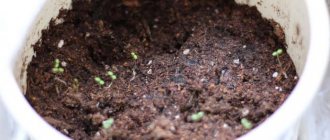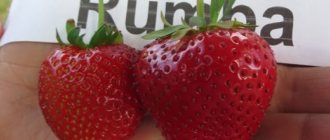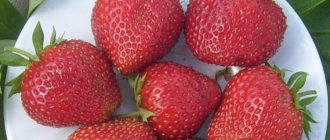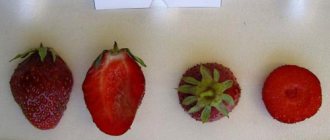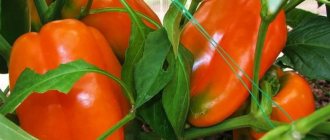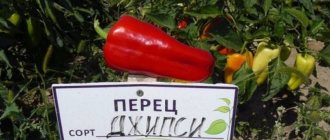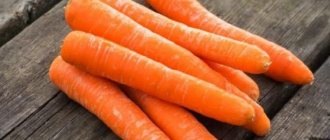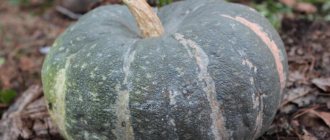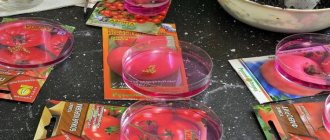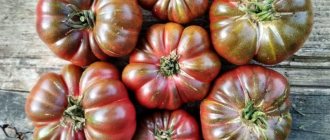Description of the decorative pumpkin variety Turkish Turban
Turkish turban is a plant with beautiful faceted leaves up to 2.5 meters long . Pumpkin flowers are bell-shaped, bright yellow, and quite large (10 cm in diameter).
The shape of the fruits resembles a headdress from Turkey, a turban or turban. They are miniature and colorful. One plant can bear up to 30 fruits .
The Turkish turban is growing rapidly. The stems reach 6 m or more (if they are not pinched). They quickly climb up a vertical support, decorating the garden and creating cool shade in the area.
Decorative pumpkin is drought-resistant and heat-loving. Reacts well to organic fertilizers. Shoots and fruits do not tolerate frost.
The fruits of the Turkish Turban variety have an unusual turban shape
Characteristics of the variety
The weight of a pumpkin varies on average from 0.5 to 2.0 kg, with a diameter of 10-15 cm. However, there are specimens that gain weight up to 4-5 kg. The color of the vegetables is bright orange on top with longitudinal green or red stripes, the bottom is light beige.
The variety comes from Chile, from where it came to the American breeder Luther Burbank. He managed to select the highest quality ones from the variety of vegetables obtained and as a result developed a resistant variety.
Pumpkin is considered decorative: the bush is compact, climbing (they grow up to 3-4 m), while it is well leafy and quickly forms a thick green mass. The foliage is small, the stems are thin, there are a large number of side shoots. Blooms with large yellow flowers. The fruits are varied, but all have a turban-shaped shape reminiscent of a mushroom.
Seedling
In the southern regions of Russia, pumpkin seeds in mid-May . Decorative pumpkin grows quickly. In one season, it manages to grow and bear fruit with proper care.
At a temperature of -1, the sprouts die, so in regions to the north the seeds are planted as seedlings. In addition, the seedling planting method will accelerate growth and maturation.
Before planting, the seeds are soaked for an hour in warm water or in a growth preparation. Then the seeds are transferred to gauze and left warm for 2 days. There they sprout. Seeds are planted in separate containers of 500 ml each.
The soil for seedlings needs fertile, loose and slightly acidic . To do this, take soil from the garden bed and mix it with:
- sod land
- sand
- humus
Before planting, the soil is disinfected with a weak solution of potassium permanganate to avoid the development of fungal diseases in the pumpkin.
Pumpkin seeds Turkish turban
The first week and a half the sprouts actively stretch, and after that their growth slows down. Plants are fed with mineral fertilizers and manure, the soil is loosened and watered .
Replanting a pumpkin is unacceptable; stress will destroy the fragile plant.
Two weeks before planting, the seedlings are hardened off - taken out into the open air and left for 15-20 minutes. Gradually increase the time to 2-3 hours.
What’s the beauty: why it’s worth planting
Beautiful massive vines of decorative pumpkin form green screens in summer, entwining gazebos, fences, arches, and trellises. The length of the shoots sometimes exceeds 4-6 meters.
The peak of decorativeness comes with flowering and ripening. In mid-summer, large sunny buds attract the eye. By autumn, instead of them, fruits of unusual shape and colorful shades are already showing off - tangerines, pears, stars. It looks attractive and pleases the eye. Landscape designers advise using:
- Climbing varieties for decoration and vertical landscaping;
- Bush varieties for planting in containers and flowerpots;
- Spectacular fruits for arranging recreation areas, children's gardens and terraces.
Growing pumpkins is a great educational activity for kids. Children love to plant, tinker with the fast-growing bush, and play with large seeds and strange fruits.
You can cut decorative candlesticks, bowls, vases, original boxes, houses and carriages from pumpkins. For babies, pumpkins are turned into rattles, maracas, mobiles, and funny toys - koloboks, owls, nesting dolls.
Bright orange pumpkin fruits are convenient to use as a stylish decoration for the kitchen, living room, or nursery (in country or rustic style).
Suitable for this:
- Lagenaria. Hard-skinned varieties are ideal for creating pumpkin dishes and bird houses;
- Cucurbits. Interesting shape and unusual surface. Color ranges from white-olive to reddish-orange.
Popular: Decoration and spicy pepper dish on the windowsill
Pumpkins of fancy shapes are included in decorative compositions. You can prepare a creative setting for Halloween and make a scary Jack mask. For high-tech, the fruits are given a white or silver color.
Planting in open ground
A month later, when 2-3 leaves , the seedlings are planted in open ground. IMPORTANT. Next to the sprouts there should be a strong vertical support, for example a wall or arch, along which they will grow.
Turkish turban is a light-loving plant; the variety requires a lot of sunlight . Before planting, the soil is dug up and fertilized with organic (manure or compost) fertilizers.
Prepare a hole for each sprout and water it generously. Sprouts from seedlings are planted in holes at a distance of half a meter from each other.
The Turkish Turban variety requires a lot of light during cultivation.
Pumpkin care
Decorative pumpkin is an unpretentious plant. It requires constant abundant watering and loosening of the soil. When the first ovaries appear, the sprouts are generously fertilized.
In addition to loosening and weeding, gardeners sprinkle the soil around the sprouts with sawdust or humus (mulch). It helps:
- fertilize the soil
- retain moisture
- maintain soil looseness
- prevent diseases from spreading from the soil to plants when watering or raining
Topsoil is important for pumpkins because of the structure of its root system. It has a long main root and many small roots that grow closer to the surface.
Mulched plants bear fruit more abundantly and are less susceptible to disease.
To make a “lush hedge” from the Turkish turban, gardeners pinch out the top shoots when they reach a length of one meter.
Fruits must be cut together with the stalk before frost occurs.
The fruits are cut together with the stalk before the first frost, in September . Frozen pumpkins do not last long. To prevent their bright color from fading, after harvesting they are stored away from direct sunlight.
Features of growing decorative pumpkins
Growing seedlings includes a number of the following actions:
- preparation of seed material - disinfection, hardening, germination;
- sowing of seeds for seedlings is carried out in late April - early May;
- the crop does not like replanting, so sow one seed per pot with a diameter of at least 15 cm;
- after 12 days, sprinkle the plant with soil, up to the cotyledon leaves;
- We feed the seedlings twice with mineral fertilizers or slurry;
- we transplant the seedlings after 30 days, when it has five true leaves;
- before planting, weed the ground and apply fertilizer;
- Make holes for the plant and pour 1 liter of water into each hole.
Also, the seeds take root well if sown directly in the ground. This is done after the frosts have irrevocably passed - the soil temperature should be at least 13 ° C.
When growing crops, the following conditions will need to be met:
- timely watering and fertilizing of the plant, loosening the soil and removing weeds;
- installation of a reliable structure to support the plant;
- pinching the central shoot, which has grown to one meter, so that lateral shoots form;
- inspection of the plant for timely detection of pests and diseases;
- after full ripening, harvest the fruits (before frost).
Important! The area for growing the crop should be sunny, the soil should be well heated. The plant is afraid of frost.
Application of fruits
Skilled hands can make crafts from ripe fruits to decorate the home . Gardeners carve beautiful patterns and compositions on pumpkins and cover them with varnish. They are used to make jugs, cups and lamps.
Children enjoy drawing on the crust with paints. Using plasticine and old things, they make funny characters and cute animals.
Both adults and children can get creative together and assemble an autumn still life from pumpkins, spruce branches and fallen leaves that will remind you of a fruitful year.
Harvesting and storage
Vegetables are often cut unripe so that they do not become tough. During the ripening process, the gastronomic qualities improve.
Shelf life at home is about 12 months. Proper harvesting allows you to ensure long-term shelf life - cut the pumpkin with a stand at least 5 cm long.
During storage until spring, vegetables harden even more and become a suitable material for the production of vases and other decorative items.
Seeds for subsequent planting are stored in the fall. A suitable place is wet sand. It is permissible to store in the refrigerator or on the balcony loggia.
3. GARDEN Turban gourd
Pumpkin: what they are and what can be made from them. Pumpkin candle – 7 cottages
Pumpkin mushroom "Little Red Riding Hood" in our garden!
Is it possible to eat decorative pumpkins?
The fruits of the Turkish Turban are edible.
The fruits of the Turkish turban are edible, but tasteless
As long as the skin on them is not roughened, they can be eaten and given to animals. The upper part - the cap - is suitable for making soup or stew; it can be boiled. The lower part of the fruit is full of seeds and is therefore not suitable for food.
Pumpkin fruits are tasteless . They are more likely to please the gardener as a decorative decoration for the home and garden than as a tasty treat on the table.
Diseases and pests
- Bacteriosis is the most common pumpkin disease. Its main symptom is the appearance of brown spots on the leaves. If the disease is not treated, it will infect the fruit with cankers. To prevent bacteriosis, gardeners spray plants with Bordeaux mixture. At the first signs of disease, plants are sprayed with a mixture of lime and copper sulfate. Affected and dead shoots are removed from the garden so as not to infect healthy ones.
- White rot . The sprouts are affected by a white coating and then rot. This happens when there is excess moisture. The source of white rot is marsupial fungus. Prevention of white rot is to water the plants with warm water. Dead leaves are cut off, and the cut area is sprinkled with activated carbon.
v Root rot . Affects stems and roots. The reason for its occurrence is cold water and temperature changes. To avoid this, the sprouts are cared for by being mulched. Affected plants are treated with a mixture of copper sulfate and zinc sulfate dissolved in water.
- Melon aphid . A small (up to 2 mm) insect that causes pumpkin leaves and flowers to fall off. They get rid of melon aphids by spraying the affected plants with a decoction of wormwood or a solution of karbofos.
Growing a Turkish turban on a plot of land is simple and does not take much time. The effort spent on planting it will more than pay off. The variety is unpretentious. While it grows, it will delight you with its beauty for months. Its green mass will make the garden shady and cool in the heat. And the fruits of the Turkish turban are a source of beautiful crafts that will fill your home with comfort.

